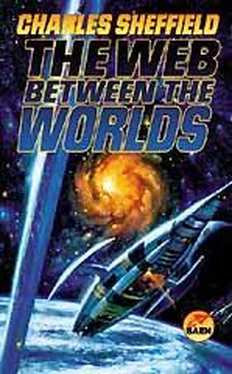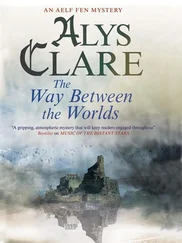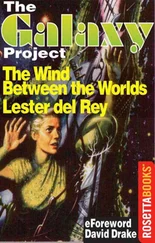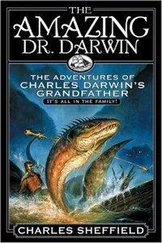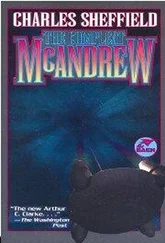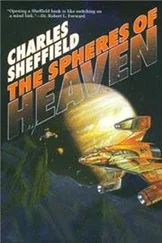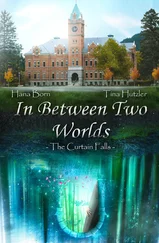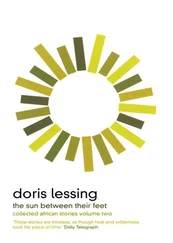The Web Between the Worlds
by Charles Sheffield
For Linda
An open letter to the Bulletin of the Science Fiction Writers of America
Early in 1979 I published a novel, The Fountains of Paradise , in which an engineer named Morgan, builder of the longest bridge in the world, tackles a far more ambitious project — an “orbital tower” extending from a point on the equator to geostationary orbit. Its purpose: to replace the noisy, polluting and energy-wasteful rocket by a far more efficient electric elevator system. The construction material is a crystalline carbon filter, and a key device in the plot is a machine named “Spider.”
A few months later another novel appeared in which an engineer named Merlin, builder of the longest bridge in the world, tackles a far more ambitious project — an “orbital tower,” etc. etc. The construction material is a crystalline silicon fiber, and a key device in the plot is a machine named “Spider”…
A clear case of plagiarism? No — merely an idea whose time has come. And I’m astonished that it hasn’t come sooner.
The concept of the “space elevator” was first published in the West in 1966 by John Isaacs and his team at La Jolla. They were greatly surprised to discover that a Leningrad engineer, Yuri Artsutanov, had anticipated them in 1960; his name for the device was a “cosmic funicular.” There have since been at least three other independent “inventions” of the idea.
I first mentioned it in a speech to the American Institute of Architects in May 1967 (see “Technology and the Future” in Report on Planet Three ) and more recently (July 1975) in an address to the House of Representatives Space Committee (see The View From Serendip ). However, although I had been thinking about The Fountains of Paradise for almost two decades, it was not until a very few years ago that I decided to use the orbital tower as its theme. One reason for my reluctance was, I suspect, an unconscious fear that, surely , some science-fiction writer would soon latch on to such a gorgeous idea. Then I decided that I simply had to use it — even if Larry Niven came out first…
Well, Charles Sheffield (currently President of the American Astronautical Association and V/P of the Earth Satellite Corporation) only missed by a few months with his Ace novel The Web Between the Worlds . (Incidentally, that would have been a good title for Brian Aldiss’ marvellous fantasy Hothouse , [a.k.a. The Long Afternoon of Earth ] which had spiderwebs linking Earth and Moon!) I am much indebted to Dr. Sheffield for sending me the ms. of his novel; and if you want another coincidence, I had just started reading his first novel, Sight of Proteus (Ace), when the second one arrived…
Anyone reading our two books will quickly see that the parallels were dictated by the fundamental mechanics of the subject — though in one major respect we evolved totally different solutions. Dr. Sheffield’s method of anchoring his “Beanstalk” is hair-raising, and I don’t believe it would work. I’m damn sure it wouldn’t be permitted!
I’m writing this letter to put the record straight, and to divert any possible charges from Dr. Sheffield. But I’d also like to satisfy my own curiosity.
It still seems inconceivable to me that, in the eighteen years since it’s been circulating, no one has used this idea in fiction — especially now that it is being taken more and more seriously in non -fiction, with a rapidly expanding literature. (I expect to give a survey paper on the subject at the annual International Astronautical Federation Congress, Munich, 20 September 1979). I no longer — alas — have the time to read the S.F. magazines, or more than even a tenth of the good books published. So I’d appreciate any information on this point, before I get charged with plagiarism.
As for the rest of you — go right ahead. Charles Sheffield and I have just scratched the surface. The Space Elevator (and its various offspring, some even more fantastic) may be the great engineering achievement of the Twenty-first century, making travel round the solar system no more expensive than any other form of transportation.
Arthur C. Clarke
17 January 1979
Introduction to This Edition
The idea of a space elevator, a load-bearing cable that extends from the surface of the earth to high orbit and beyond, is an old one. It was first suggested by Tsiolkovsky in 1895, as a passing comment and with no analysis of the idea. Sixty-five years later, in 1960, the concept was rediscovered and explored in more detail by another Russian, Artsutanov. His work in turn remained unknown in the West until 1966, when the idea was rediscovered by Isaacs, Vine, Bradner, and Bachus. Since then it has been “discovered” at least three more times.
However, the notion of the space elevator, also known as a skyhook, a heavenly funicular, an anchored satellite, an orbital tower, and my own favorite name, a beanstalk, was still new to science fiction in 1978. When I sent a short story about beanstalks, “Skystalk,” to the science fiction magazines, the response was not encouraging. The editor of Asimov ’s magazine, George Scithers, in an unusually frank rejection slip, said, “Neither I nor anyone on my staff understands this story.” The editor of Analog magazine, Stan Schmidt, was more encouraging, asking, “Is the idea in this story really feasible?” But he still rejected it. And when it was finally bought by Jim Baen, in December, 1978, for publication in Destinies magazine, he suggested that I write an accompanying article, explaining the dynamics and physics behind what might otherwise seem an outrageous idea.
All this made me feel somewhat insecure. At the time I was busy writing a whole novel centered on beanstalks. Suppose that the readers and reviewers rejected the whole thing as scientifically impossible?
And then, in the fall of 1978, I heard from Fred Durant. He was and is a friend of mine, and Arthur Clarke’s oldest friend in the United States. Fred lived just a couple of miles away from me, and he spoke with Clarke frequently by telephone. Arthur, he told me, was finishing a new novel — a novel in which a space elevator was a main element.
I won’t say I was pleased. Nervous is a better word. I had never met Arthur Clarke, but at Fred Durant’s suggestion, not to say insistence, I took my completed manuscript and sent a copy to Clarke in Sri Lanka. I had no idea what to expect; what I certainly didn’t expect was what came: first, a very friendly letter from Arthur Clarke, and, soon after, an open letter from him to the Science Fiction Writers of America, stating that coincidence, not plagiarism, lay behind the fact that two books were to be published in 1979 with strikingly similar themes. Not just the space elevator, but each book had as main character the world’s leading bridge-builder; each one employed a device known as a Spider.
The fear that the idea would be mocked disappeared. All that was left were questions that remain to this day. If Clarke had not published his The Fountains of Paradise , how would my The Web Between the Worlds have been received? Would my book have been hailed, as the source of a big idea new to science fiction? Or would it have suffered instant obscurity, as a piece of science fantasy?
I’ll never know.
The voice began again in her ear as she hurried into the airport. It was the merest thread of sound, carrying through the implanted receiver.
Читать дальше
